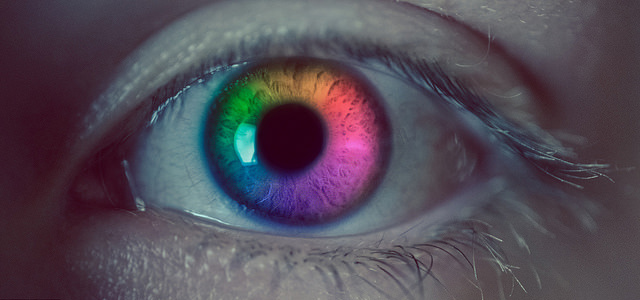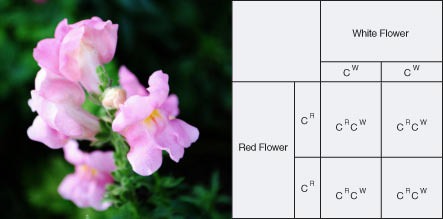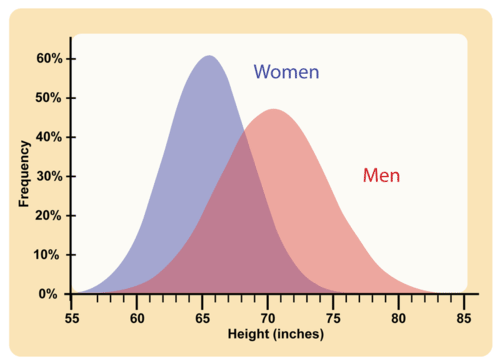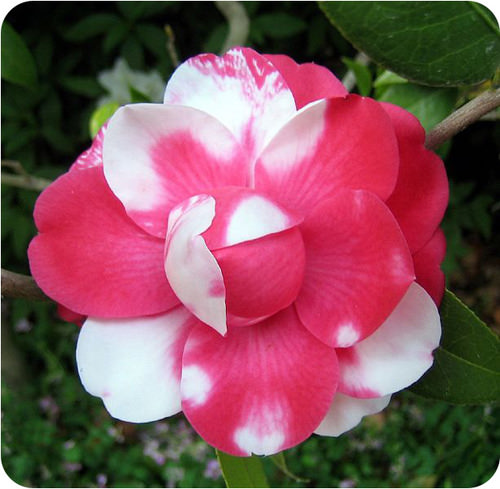3.13: Non-Mendelian Inheritance
- Page ID
- 12062
\( \newcommand{\vecs}[1]{\overset { \scriptstyle \rightharpoonup} {\mathbf{#1}} } \)
\( \newcommand{\vecd}[1]{\overset{-\!-\!\rightharpoonup}{\vphantom{a}\smash {#1}}} \)
\( \newcommand{\dsum}{\displaystyle\sum\limits} \)
\( \newcommand{\dint}{\displaystyle\int\limits} \)
\( \newcommand{\dlim}{\displaystyle\lim\limits} \)
\( \newcommand{\id}{\mathrm{id}}\) \( \newcommand{\Span}{\mathrm{span}}\)
( \newcommand{\kernel}{\mathrm{null}\,}\) \( \newcommand{\range}{\mathrm{range}\,}\)
\( \newcommand{\RealPart}{\mathrm{Re}}\) \( \newcommand{\ImaginaryPart}{\mathrm{Im}}\)
\( \newcommand{\Argument}{\mathrm{Arg}}\) \( \newcommand{\norm}[1]{\| #1 \|}\)
\( \newcommand{\inner}[2]{\langle #1, #2 \rangle}\)
\( \newcommand{\Span}{\mathrm{span}}\)
\( \newcommand{\id}{\mathrm{id}}\)
\( \newcommand{\Span}{\mathrm{span}}\)
\( \newcommand{\kernel}{\mathrm{null}\,}\)
\( \newcommand{\range}{\mathrm{range}\,}\)
\( \newcommand{\RealPart}{\mathrm{Re}}\)
\( \newcommand{\ImaginaryPart}{\mathrm{Im}}\)
\( \newcommand{\Argument}{\mathrm{Arg}}\)
\( \newcommand{\norm}[1]{\| #1 \|}\)
\( \newcommand{\inner}[2]{\langle #1, #2 \rangle}\)
\( \newcommand{\Span}{\mathrm{span}}\) \( \newcommand{\AA}{\unicode[.8,0]{x212B}}\)
\( \newcommand{\vectorA}[1]{\vec{#1}} % arrow\)
\( \newcommand{\vectorAt}[1]{\vec{\text{#1}}} % arrow\)
\( \newcommand{\vectorB}[1]{\overset { \scriptstyle \rightharpoonup} {\mathbf{#1}} } \)
\( \newcommand{\vectorC}[1]{\textbf{#1}} \)
\( \newcommand{\vectorD}[1]{\overrightarrow{#1}} \)
\( \newcommand{\vectorDt}[1]{\overrightarrow{\text{#1}}} \)
\( \newcommand{\vectE}[1]{\overset{-\!-\!\rightharpoonup}{\vphantom{a}\smash{\mathbf {#1}}}} \)
\( \newcommand{\vecs}[1]{\overset { \scriptstyle \rightharpoonup} {\mathbf{#1}} } \)
\( \newcommand{\vecd}[1]{\overset{-\!-\!\rightharpoonup}{\vphantom{a}\smash {#1}}} \)
\(\newcommand{\avec}{\mathbf a}\) \(\newcommand{\bvec}{\mathbf b}\) \(\newcommand{\cvec}{\mathbf c}\) \(\newcommand{\dvec}{\mathbf d}\) \(\newcommand{\dtil}{\widetilde{\mathbf d}}\) \(\newcommand{\evec}{\mathbf e}\) \(\newcommand{\fvec}{\mathbf f}\) \(\newcommand{\nvec}{\mathbf n}\) \(\newcommand{\pvec}{\mathbf p}\) \(\newcommand{\qvec}{\mathbf q}\) \(\newcommand{\svec}{\mathbf s}\) \(\newcommand{\tvec}{\mathbf t}\) \(\newcommand{\uvec}{\mathbf u}\) \(\newcommand{\vvec}{\mathbf v}\) \(\newcommand{\wvec}{\mathbf w}\) \(\newcommand{\xvec}{\mathbf x}\) \(\newcommand{\yvec}{\mathbf y}\) \(\newcommand{\zvec}{\mathbf z}\) \(\newcommand{\rvec}{\mathbf r}\) \(\newcommand{\mvec}{\mathbf m}\) \(\newcommand{\zerovec}{\mathbf 0}\) \(\newcommand{\onevec}{\mathbf 1}\) \(\newcommand{\real}{\mathbb R}\) \(\newcommand{\twovec}[2]{\left[\begin{array}{r}#1 \\ #2 \end{array}\right]}\) \(\newcommand{\ctwovec}[2]{\left[\begin{array}{c}#1 \\ #2 \end{array}\right]}\) \(\newcommand{\threevec}[3]{\left[\begin{array}{r}#1 \\ #2 \\ #3 \end{array}\right]}\) \(\newcommand{\cthreevec}[3]{\left[\begin{array}{c}#1 \\ #2 \\ #3 \end{array}\right]}\) \(\newcommand{\fourvec}[4]{\left[\begin{array}{r}#1 \\ #2 \\ #3 \\ #4 \end{array}\right]}\) \(\newcommand{\cfourvec}[4]{\left[\begin{array}{c}#1 \\ #2 \\ #3 \\ #4 \end{array}\right]}\) \(\newcommand{\fivevec}[5]{\left[\begin{array}{r}#1 \\ #2 \\ #3 \\ #4 \\ #5 \\ \end{array}\right]}\) \(\newcommand{\cfivevec}[5]{\left[\begin{array}{c}#1 \\ #2 \\ #3 \\ #4 \\ #5 \\ \end{array}\right]}\) \(\newcommand{\mattwo}[4]{\left[\begin{array}{rr}#1 \amp #2 \\ #3 \amp #4 \\ \end{array}\right]}\) \(\newcommand{\laspan}[1]{\text{Span}\{#1\}}\) \(\newcommand{\bcal}{\cal B}\) \(\newcommand{\ccal}{\cal C}\) \(\newcommand{\scal}{\cal S}\) \(\newcommand{\wcal}{\cal W}\) \(\newcommand{\ecal}{\cal E}\) \(\newcommand{\coords}[2]{\left\{#1\right\}_{#2}}\) \(\newcommand{\gray}[1]{\color{gray}{#1}}\) \(\newcommand{\lgray}[1]{\color{lightgray}{#1}}\) \(\newcommand{\rank}{\operatorname{rank}}\) \(\newcommand{\row}{\text{Row}}\) \(\newcommand{\col}{\text{Col}}\) \(\renewcommand{\row}{\text{Row}}\) \(\newcommand{\nul}{\text{Nul}}\) \(\newcommand{\var}{\text{Var}}\) \(\newcommand{\corr}{\text{corr}}\) \(\newcommand{\len}[1]{\left|#1\right|}\) \(\newcommand{\bbar}{\overline{\bvec}}\) \(\newcommand{\bhat}{\widehat{\bvec}}\) \(\newcommand{\bperp}{\bvec^\perp}\) \(\newcommand{\xhat}{\widehat{\xvec}}\) \(\newcommand{\vhat}{\widehat{\vvec}}\) \(\newcommand{\uhat}{\widehat{\uvec}}\) \(\newcommand{\what}{\widehat{\wvec}}\) \(\newcommand{\Sighat}{\widehat{\Sigma}}\) \(\newcommand{\lt}{<}\) \(\newcommand{\gt}{>}\) \(\newcommand{\amp}{&}\) \(\definecolor{fillinmathshade}{gray}{0.9}\)
Green, blue, brown, black, hazel, violet, or grey. What color are your eyes?
Of course human eyes do not come in multi-color, but they do come in many colors. How do eyes come in so many colors? That brings us to complex inheritance patterns, known as non-Mendelian inheritance. Many times inheritance is more complicated than the simple patterns observed by Mendel.
Non-Mendelian Inheritance
The inheritance of characteristics is not always as simple as it is for the characteristics that Mendel studied in pea plants. Each characteristic Mendel investigated was controlled by one gene that had two possible alleles, one of which was completely dominant to the other. This resulted in just two possible phenotypes for each characteristic. Each characteristic Mendel studied was also controlled by a gene on a different (nonhomologous) chromosome. As a result, each characteristic was inherited independently of the other characteristics. Geneticists now know that inheritance is often more complex than this.
A characteristic may be controlled by one gene with two alleles, but the two alleles may have a different relationship than the simple dominant-recessive relationship that you have read about so far. For example, the two alleles may have a codominant or incompletely dominant relationship. The former is illustrated by the flower in the Figure below, and the latter in the Figure below.
Codominance
Codominance occurs when both alleles are expressed equally in the phenotype of the heterozygote. The red and white flower in the figure has codominant alleles for red petals and white petals.
Codominance. The flower has red and white petals because of codominance of red-petal and white-petal alleles.
Incomplete Dominance
Incomplete dominance occurs when the phenotype of a heterozygote offspring is somewhere in between the phenotypes of both homozygous parents; a completely dominant allele does not occur. For example, when red snapdragons (CRCR) are crossed with white snapdragons (CWCW), the F1 hybrids are all pink heterozygotes for flower color (CRCW). The pink color is an intermediate between the two parent colors. When two F1 (CRCW) hybrids are crossed they will produce red, pink, and white flowers. The genotype of an organism with incomplete dominance can be determined from its phenotype (Figure below).
 Incomplete Dominance. The flower has pink petals because of incomplete dominance of a red-petal allele and a recessive white-petal allele.
Incomplete Dominance. The flower has pink petals because of incomplete dominance of a red-petal allele and a recessive white-petal allele.Multiple Alleles
Many genes have multiple (more than two) alleles. An example is ABO blood type in humans. There are three common alleles for the gene that controls this characteristic. The alleles IA and IB are dominant over i. A person who is homozygous recessive ii has type O blood. Homozygous dominant IAIA or heterozygous dominant IAi have type A blood, and homozygous dominant IBIB or heterozygous dominant IBi have type B blood. IAIB people have type AB blood, because the A and B alleles are codominant. Type A and type B parents can have a type AB child. Type A and type B parents can also have a child with Type O blood, if they are both heterozygous (IBi, IAi).
- Type A blood: IAIA, IAi
- Type B blood: IB IB, IB i
- Type AB blood: IAIB
- Type O blood: ii
Polygenic Characteristics
Polygenic characteristics are controlled by more than one gene, and each gene may have two or more alleles. The genes may be on the same chromosome or on nonhomologous chromosomes.
- If the genes are located close together on the same chromosome, they are likely to be inherited together. However, it is possible that they will be separated by crossing-over during meiosis, in which case they may be inherited independently of one another.
- If the genes are on nonhomologous chromosomes, they may be recombined in various ways because of independent assortment.
For these reasons, the inheritance of polygenic characteristics is very complicated. Such characteristics may have many possible phenotypes. Skin color and adult height are examples of polygenic characteristics in humans. Do you have any idea how many phenotypes each characteristic has?
 Human Adult Height. Like many other polygenic traits, adult height has a bell-shaped distribution.
Human Adult Height. Like many other polygenic traits, adult height has a bell-shaped distribution.Effects of Environment on Phenotype
Genes play an important role in determining an organism’s characteristics. However, for many characteristics, the individual’s phenotype is influenced by other factors as well. Environmental factors, such as sunlight and food availability, can affect how genes are expressed in the phenotype of individuals. Here are just two examples:
- Genes play an important part in determining our adult height. However, factors such as poor nutrition can prevent us from achieving our full genetic potential.
- Genes are a major determinant of human skin color. However, exposure to ultraviolet radiation can increase the amount of pigment in the skin and make it appear darker.
Summary
- Many characteristics have more complex inheritance patterns than those studied by Mendel. They are complicated by factors such as codominance, incomplete dominance, multiple alleles, and environmental influences.
Review
- A classmate tells you that a person can have type AO blood. Do you agree? Explain.
- Mendelian inheritance does not apply to the inheritance of alleles that result in incomplete dominance and codominance. Explain why this is so.
- Describe the relationship between environment and phenotype.
- Mendel investigated stem length, or height, in pea plants. What if he had investigated human height instead? Why would his results have been harder to interpret?
| Image | Reference | Attributions |
 |
[Figure 1] | Credit: Mariana Ruiz Villarreal (LadyofHats) for CK-12 Foundation Source: CK-12 Foundation License: CC BY-NC 3.0 |
 |
[Figure 2] | Credit: Darwin Cruz;Jodi So Source: commons.wikimedia.org/wiki/File:Co-dominance_Rhododendron.jpg ; CK-12 Foundation License: CC BY 2.0; CC BY-NC 3.0 |
 |
[Figure 3] | Credit: Flower: Sandy Schultz;Jodi So Source: Flower: http://www.flickr.com/photos/chatblanc1/4788366795/ ; CK-12 Foundation License: Flower: CC BY 2.0; CC BY-NC 3.0 |
 |
[Figure 4] | Credit: Mariana Ruiz Villarreal (LadyofHats) for CK-12 Foundation;Jodi So Source: CK-12 Foundation License: CC BY-NC 3.0 |


